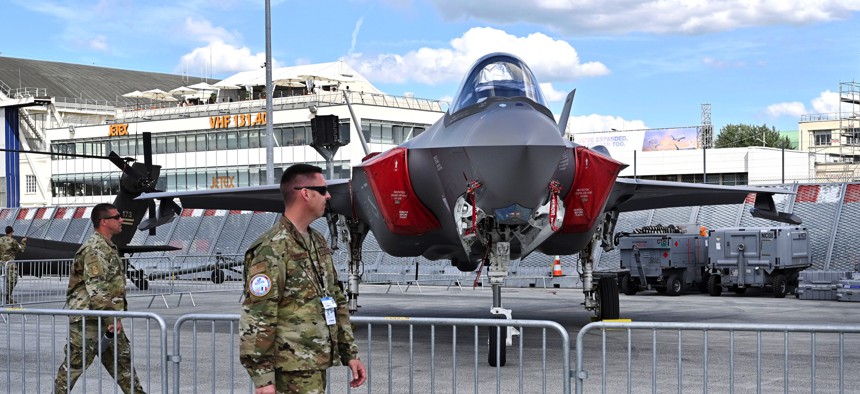
A Lockheed Martin F-35 fighter on display at the 2019 Paris Air Show. Mustafa Yalcin/Anadolu Agency/Getty Images
Pratt & Whitney Angered by Lockheed’s Support for New F-35 Engine
Engine-maker says prime contractor is exaggerating the jet’s future role.
LE BOURGET, France—Pratt & Whitney is miffed over Lockheed Martin’s support for a new jet engine that one day might replace the one it makes for the F-35 stealth fighter.
Tensions spilled over at the Paris Air Show this week, as Pratt executives accused a Lockheed executive of making misleading statements about the F-35’s purported need for a new engine years from now. Pratt accused Lockheed of trying to market the F-35 as a sixth-generation fighter jet.
“We’re not surprised Lockheed Martin is angling to market the F-35 as a 6th-generation fighter, which it never will be, with the intent to delay or negate the need for a 6th-generation fighter competition and extend the life and longevity of their contract,” Jeff Shockey, senior vice president of global government relations for Raytheon Technologies, told Defense One Wednesday. Pratt is a subsidiary of Raytheon.
The Adaptive Engine Transition Program, or AETP, is an Air Force effort to develop a powerful, but fuel-efficient engine for future warplanes. The plan is to use the new engine technology in the Air Force’s Next Generation Air Dominance fighter jet. But the tech could also benefit the F-35, keeping that plane flying for five decades. Pratt and GE teams are both working on their own adaptive engine proposals.
The Air Force’s fiscal 2024 budget proposal aims to end funding for the AETP engine, declaring the effort too expensive and cementing the plan to press on with Pratt’s proposed upgrade to the F-35’s current engine.
But as Congress reviews the budget proposal, Lockheed has begun issuing public support for the new engine.
“I am an advocate for AETP,” the Adaptive Engine Transition Program, Greg Ulmer, executive vice president of Lockheed’s Aeronautics business, told Defense One Tuesday. “I believe the F-35 is going to be around [until] 2070. There’s going to be a Block 5, there’s going to be a Block 6, probably a Block 7. We’re going to need more power and cooling. It’s just a fact of life.”
Ulmer’s comments prompted Pratt executives to fire back, saying Lockheed’s support for a new F-35 engine reflects an unwise attempt to prolong the jet’s service.
House Armed Services Committee Chairman Rep. Mike Rogers’ markup of the annual defense policy bill would keep the adaptive program alive, but this reversal of the Air Force’s decision still requires the approval of Senate authorizers and appropriators in both houses.
Shockey said House authorizers made it clear in their markup that the purpose of funding AETP is to keep the industrial base going on next-gen engine technology for a future fighter. But now Lockheed is “trying to shift the debate...tell one story and try to go implement another story. It’s a waste of taxpayer dollars and adds tremendous risk to the program,” he said.
Proponents of the adaptive engine say it would offer more thrust while burning less fuel. Ulmer said the adaptive engine would deliver “improved performance” for the F-35, in addition to more power and cooling.
“Beyond Block 4, we need more power and cooling. What I like about AETP is you get both of those and you get specific fuel consumption improvement, so now the range of the airplane increases,” he said.
But Pratt officials argue that it’s “misleading” to say that the jet needs a new engine for power and cooling reasons—because a Lockheed-led study concluded that combining the Pratt engine upgrade with an upgraded power and thermal management system could provide 70 percent more power and cooling beyond Block 4, said Jen Latka, vice president of Pratt’s F135 program.
Even if you put an adaptive engine into the F-35, Latka said, “It will never meet the mission requirements of the 6th-gen. It is not a replacement. So we really believe that there needs to be a focus on 6th-gen airframe with a 6th-gen propulsion system.”
Both enginemaker Pratt and prime contractor Lockheed have had their fair share of problems with the F-35 program: Lockheed has struggled to deliver Block 4 upgrades for the jet and Pratt has struggled to deliver engines.

